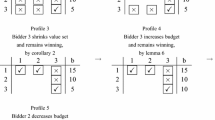Abstract
In general, synergies across license valuations complicate the auction design process. Theory suggests that a “simple” (i.e., non-combinatorial) auction will have difficulty in assigning licenses efficiently in such an environment. This difficulty increases with increases in “fitting complexity.” In some environments, bidding may become “mutually destructive.” Experiments indicate that a properly designed combinatorial auction is superior to a simple auction in terms of economic efficiency and revenue generation in bidding environments with a low amount of fitting complexity. Concerns that a combinatorial auction will cause a “threshold” problem are not borne out when bidders for small packages can communicate.
Similar content being viewed by others
References
Ausubel, L. M., P. Cramton, R. P. McAfee, and J. McMillan. 1997. “Synergies in Wireless Telephony: Evidence from the Broadband PCS Auctions.” Journal of Economics and Management Strategy 6(3): 497–527.
Banks, J. S., J. O. Ledyard, and D. Porter. 1989. “Allocating Uncertain and Unresponsive Resources: An Experimental Approach.” The Rand Journal of Economics 20: 1–25.
Benoit, J.-P., and V. Krishna. 1998. “Multiple-Object Auctions with Budget Constrained Bidders.” NYU Working Paper.
Bikhchandani, S., and J. W. Mamer. 1997. “Competitive Equilibrium in an Exchange Economy with Indivisibilities.” Journal of Economic Theory 74(2): 385–413.
Bikhchandani, S., and J. M. Ostroy. 1998. “The Package Assignment Model.” UCLAWorking Paper.
Bikhchandani, S. 1999. “Auctions of Heterogeneous Objects.” Games and Economic Behavior 26(2): 193–220.
Branco, F. 1997. “Multiple Object Auctions with Synergies.” Unpublished Manuscript.
Branco, F. 1995. “Multi-object Auctions: On the Use of Combinatorial Bids.” CEPR Discussion Paper #1216.
Bykowsky, M. M., and R. Cull. 1993. “Issues in Implementing a Personal Communications Services Auction.” Attached to Comments of the National Telecommunications and Information Administration in PP Docket No. 93–253.
Bykowsky, M. M., and R. Cull. 1994. “Personal Communications Services Auction: Further Analysis.” Attached to Ex Parte Submission of National Telecommunications and Information Administration in PP Docket No. 93–253.
Chakravorti, B., W. W. Sharkey, Y. Spiegel, and S. Wilkie. 1995. “Auctioning the Airwaves: The Contest for Radio Spectrum.” Journal of Economics and Management Strategy 4: 345–373.
DeMartini, C., A. M. Kwasnica, J. O. Ledyard, and D. Porter. 1998. “A New and Improved Design for Iterative Auctions.” CalTech Working Paper #1054.
Federal Communications Commission. 1993. Implementation of Section 309( j) of the Communications Act Competitive Bidding, Notice of Proposed Rule Making, PP Docket No. 93–253 (adopted Sept 23, 1993, released Oct 12, 1993).
Federal Communications Commission. 1993. Amendment of the Commission's Rules to Establish New Personal Communications Services, Second Report and Order, No. 90–314 (adopted Sept 23, 1993, released Oct 22, 1993).
Federal Communications Commission. 1993. Redevelopment of Spectrum to Encourage Innovation in the Use of New Telecommunications Technologies, Third Report and Order and Memorandum Opinion and Order, FCC Rcd 6589.
Harris, R. G., and M. L. Katz. 1993. “A Public Interest Assessment of Spectrum Auctions for Wireless Telecommunications Services.” Attached to Comments of Nynex Corporation in PP Docket No. 93–253.
Harstad, R. M., and M. H. Rothkopf. 1996. “Combinatorial Auctions with Synergies.” Unpublished Manuscript.
Isaac, R. M. 1993. “Discussion of Proposed Spectrum Auction Processes.” Attached to Comments of the Cellular Telephone Industry Association in PP Docket No. 93–253.
Koopmans, T. C., and M. Beckmann. 1957. “Assignment Problems and the Location of Economic Activities.” Econometrica 25: 53–76.
Krishna, V., and R. W. Rosenthal. 1996. “Simultaneous Auctions with Synergies.” Games and Economic Behavior 17: 1–31.
Ledyard, J. O. 1999. “Public Goods: A Survey of Experimental Research.” In The Handbook of Experimental Economics. edited by J. H. Kagel, and A. E. Roth. Princeton, NJ: Princeton University Press. Also available as a CalTech Working Paper #861 (1994).
Ledyard, J. O., C. Noussair, and D. Porter. 1996. “The Allocation of a Shared Resource Within an Organization.” Economic Design 2(2): 163–192.
Ledyard, J. O., D. Porter, and A. Rangel. 1997. “Experiments Testing Multi-object Allocation Mechanisms.” Journal of Economics and Management Strategy 6(3): 634–675.
McAfee, R. P. 1993. “Auction Design of Personal Communications Services.” Attached to Comments of PacTel Corporation in PP Docket No. 93–253.
Milgrom, P. R. 1997. “Putting Auction Theory to Work: The Simultaneous Ascending Auction.” Stanford University Working Paper.
Milgrom, P. R., and R. B. Wilson. 1993. “Affidavit of Paul R. Milgrom and Robert B. Wilson.” Attached to Comments of Pacific Bell and Nevada Bell in PP Docket No. 93–253.
Nalebuff, B. J., and J. I. Bulow. 1993. “Designing the PCS Auction.” Attached to Comments of Bell Atlantic Personal Communications, Inc. in PP Docket No. 93–253.
Olson, M., and D. Porter. 1994. “An Experimental Examination into the Design of Decentralized Methods to Solve the Assignment Problem With and Without Money.” Economic Theory 4: 11–40.
Omnibus Budget Reconciliation Act. 1993. Pub. L. No. 103–66, 107 Stat. 312.
Plott, C. R. 1997. “Laboratory Experimental Testbeds: Applications to the PCS Auction.” Journal of Economics and Management Strategy 6(3): 605–638.
Plott, C. R. 1986. “Rational Choice in Experimental Markets.” Journal of Business 59(4): S301S327.
Porter, D. 1999. “The Effect of Bid Withdrawal in a Multi-Object Auction.” The Review of Economic Design 4(1): 73–99.
Palfrey, T. R. 1983. “Bundling Decisions by a Multi-Product Monopolist with Incomplete Information.” Econometrica 51(2): 463–483.
Rassenti, S. J., V. L. Smith, and R. L. Bulfin. 1982. “ACombinatorial Auction Mechanism for Airport Time Slot Allocation.” Bell Journal of Economics 13: 402–417.
Rothkopf, M. H., A. Pekec, and R. M. Harstad. 1998. “Computationally Manageable Combinatorial Auctions.” Management Science 44(8): 1131–1147.
Telocator PCS Section, Marketing and Consumer Affairs Committee, Service Description Subcommittee 1992. “PCS Service Descriptions.”
Weber, R. J. 1993. “A Proposed Auction Methodology for the Allocation of PCS Licenses.” Attached to the Comments of TDS in PP Docket No. 93–253.
Author information
Authors and Affiliations
Rights and permissions
About this article
Cite this article
Bykowsky, M.M., Cull, R.J. & Ledyard, J.O. Mutually Destructive Bidding: The FCC Auction Design Problem. Journal of Regulatory Economics 17, 205–228 (2000). https://doi.org/10.1023/A:1008122015102
Issue Date:
DOI: https://doi.org/10.1023/A:1008122015102




